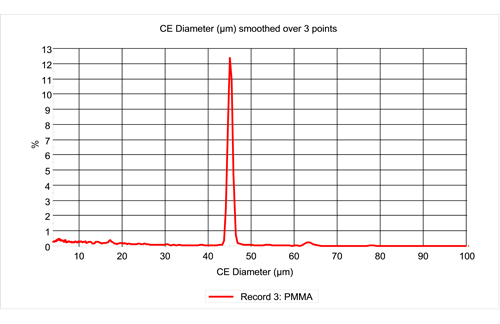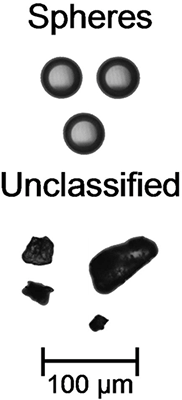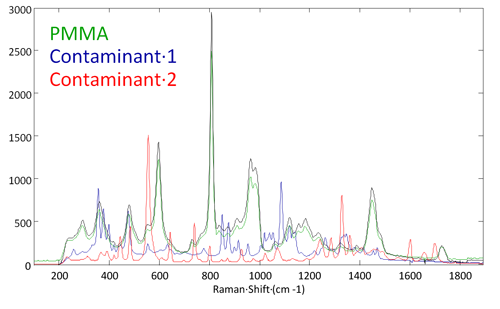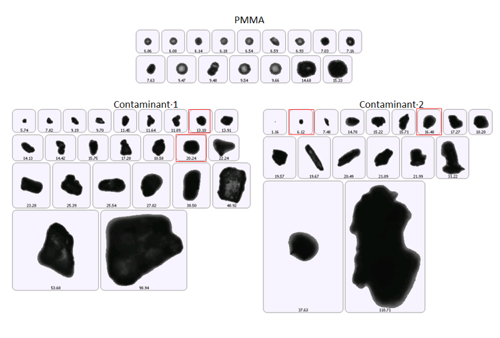In this application note Morphologically-Directed Raman Spectroscopy (MDRS®) is used to identify and characterize foreign contaminants within a sample for investigative or forensic purposes. MDRS , using the Morphologi ID transports the user from particle characterization to sample understanding, by providing chemical and morphological information about individual particles.
Careful control of particle size and shape is extremely important in the fabrication of complex, high value products. The Morphologi® ID automated particle characterization system is ideally suited to collect and analyze these parameters. Equipped with a Raman microscope, the Morphologi ID gains the additional ability to chemically identify particles via the technique of Morphologically-Directed Raman Spectroscopy (MDRS®). Chemical identification can be critical in troubleshooting out-of-specification products, answering the question: 'are outliers misshapen particles of the correct material or foreign contaminants altogether?'
A sample consisting primarily of polymer (PMMA) spheres (~45 micron diameter) was dispersed using the Morphologi ID's integrated Sample Dispersion Unit (SDU). The sample was contaminated with small levels of two known contaminants. Automated particle imaging was performed at 10X magnification and 8,837 particles were characterized in 15 minutes. The resulting circular equivalent diameter distribution of all characterized particles is shown in Figure 1.
Raman spectra of individual particles of interest are collected and compared to a library of known spectra. For this application the library contains only a few components - PMMA, and the two contaminants types. Large libraries (user created or commercially available) may also be employed, if the range of potential chemical components is broad.
Particle spectra acquired are pre-processed to minimize baseline variation and correlated with library spectra that have been similarly pre-processed. The more similar a particle spectrum is to a library component, the closer the correlation coefficient is to 1.

Figure 1: Circle equivalent (CE) diameter distribution for the PMMA sample.
The majority of particles in the sample are 45 microns in diameter, with a secondary peak near 65 microns (touching spheres). Additional particle populations, both larger and smaller, are present. This suggests outlier particles corresponding either to misshapen PMMA particles or chemically distinct contaminants. Figure 2 shows images of ~45 micron spheres along with several smaller non-spherical particles. There is a clear difference in the particle shape between the two.
The spheres shown in Figure 2 have a light region in the center of the image. The Standard Deviation in intensity across a particle (SD) is one of the parameters available for characterization in the Morphologi software. A class named "Spheres" is defined, including all particles with a circularity > 0.92 and an intensity standard deviation (SD) > 36. Particles outside of these ranges remain "unclassified" at this point in the analysis.

|
The chemical identity of individual particles provided by the Raman microscrope may be used as a definitive parameter for the differentiation of unclassified particles. First, for confirmational purposes, spectra of a subset of the particles in the "Spheres" class were collected. As expected, all had correlation coefficient values near 1.0 for PMMA. A representative Raman spectrum of a PMMA particle (black trace) along with the library component spectra are shown in Figure 3.
More interestingly, a subset of the unclassified particles was analyzed using Raman. Figure 4 shows example images of these particles - i.e. those not classified as spheres using morphological - not chemical - parameters. As expected, the two contaminants make up the bulk of this population. Of additional interest though, is the presence of small, misshapen spheres chemically identified as PMMA, previously characterized as "unclassified".
Contaminant 1 and 2 (large and non-spherical particles) are easily distinguished from 45 micron PMMA spheres using morphological parameters only. However, if one is interested in classifying misshapen PMMA particles, morphology alone is insufficient. Although the misshapen spheres tend to be more circular than the contaminant particles, this is by no means definitive. Example contaminant particles that are morphologically indistinguishable from the misshapen PMMA spheres are highlighted by red boxes in Figure 4.
The ability to unequivocally determine the chemical ID of "misshapen PMMA" contaminants is possible only with the Raman microscope. Spectroscopic classification information may be used to confirm and refine class definitions, in addition to creating new ones.

Figure 3: Raman spectra of PMMA particle (black trace) along with the library components: PMMA (green), Contaminant 1 (blue) and Contaminant 2 (red).

Figure 4: Images of particles chemically identified as PMMA, contaminant 1 or contaminant 2. Below each particle is its corresponding CE diameter in microns
The Morphologi ID enables simultaneous physical and chemical characterization of particle samples. Chemical identification can determine if outlier particles are the correct material but misshapen due to production problems or if they are genuine foreign contaminants. This provides indispensable information in correcting the problem, and reducing the incidence of out-of-specification batches.